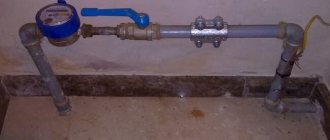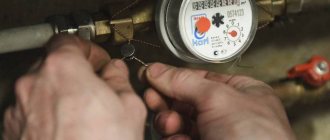Expert author of the article
Anton Bogdanov
Heat and gas supply and ventilation engineer. Prepares projects for gas supply to private houses.
A gas meter is a device installed between the main gas pipeline and appliances (gas stove, water heater, boiler). Twenty years ago, such a device in an apartment was rare, but now installing a gas meter is very important. A metering device can significantly reduce payment costs.
Is a gas meter required in an apartment?
According to paragraph 1 of Article 13 of Federal Law No. 261 “On energy saving and increasing energy efficiency and on amendments to certain legislative acts of the Russian Federation,” adopted on November 23, 2009, all devices that consume energy resources must be equipped with meters.
But there are a number of exceptions that allow you not to install measuring instruments without violating the law. If gas equipment is located in a building in emergency condition, subject to demolition or reconstruction, then it is not necessary to install a meter.
Also, a meter is not required if the volume of gas consumption does not exceed two cubic meters per hour. In simple terms, if only a gas stove is installed in the apartment, then installing a meter is not mandatory.
Is it necessary to install a gas meter?
The transition of the Russian utility system to full accounting of consumed resources began about ten years ago as a result of the need to restore order in this area. Federal Law No. 261-FZ dated November 23, 2009 was developed and adopted, requiring owners of residential and commercial premises to equip their facilities with individual meters for metering resource consumption. The requirement also applied to household gas supply systems.
According to Federal Law 261, a deadline was set - January 1, 2021, after which all apartments and houses must be equipped with an IPU. Due to the occurrence of delays and various problems that increased the excitement around the installation of gas meters, Federal Law No. 269-FZ dated December 25, 2012 was adopted: the period for installing flow meters was extended for owners of residential premises. Each owner of a real estate property is required to equip the utility supply system with a metering mechanism before January 1, 2021.
There have also been innovations in other parts of the legislation. Starting in 2021, organizations involved in supplying gas to consumers have the right to compulsorily install meters in houses and apartments. Expenses are gradually recovered from the owner of the residential premises. The owner may interfere with installation or refuse to pay for the work, so sales companies are allowed to go to court.
Is it possible to install a gas meter yourself?
Despite the apparent simplicity of installing a gas meter in an apartment, working with gas is very dangerous, and only representatives of the gas service who have permission to do this type of work can do it.
Improper installation of gas equipment can become a source of many problems not only for the apartment owner, but also for the entire building. Therefore, the restriction on self-installation of gas is justified.
Even if a professional installed the meter, this work will be illegal without contacting Gorgaz. Therefore, you cannot do without a visit to the gas service. A meter installed without their knowledge will be considered unauthorized.
Installation and Use Requirements
Requirements for installing the meter and the procedure for each stage:
- the whole process begins with submitting an application to the organization carrying out the work;
- calling a specialist to your home who will inspect the premises and prepare a recommendation;
- purchase of the structure;
- installation of a gas device;
- payment for services;
- putting the product into operation.
Meter installation procedure:
- minimum distance from the floor – 160 cm;
- gas consumption devices may be located at least 1 m from the product;
- Tight connection to the wall is not allowed (there is a gap of up to 5 cm);
- If the product will be located outdoors, then a special protective housing is attached to it.
Attention! All these requirements and rules will be advised by gas service workers at the consultation stage.
What documents are needed
Before installing a meter, you need to conclude an agreement with the city gas service.
Documents for installing a gas meter:
- Passport of the owner of the premises;
- Certificate of ownership;
- Passport for the meter;
- Passports for gas appliances;
- Plan of the gasified premises.
After collecting the documents, you need to contact Gorgaz, fill out an application for concluding an agreement there and hand it over to the employee along with all the documents. Your application will be registered and you will be contacted within 5 working days to confirm the date of the work.
Procedure for replacing equipment
The first stage of the algorithm for replacing the metering device is concluding an agreement with the company that supplies gas to the area of residence. The subject of the agreement is a set of measures to replace the device. Motive - an application submitted by the owner of the premises.
The list of documents is approved by law. And the application is written in free form on a blank sheet of paper or on the letterhead of a specialized gas company
Private gas companies operate in large cities. They have the appropriate licenses, and their employees are certified and authorized to work with gas equipment. When contacting them to change a flow meter, you must request supporting documents.
First visit to a specialist
At the first visit after concluding the contract, the technician must confirm or deny the need to purchase and install a new device. There are often situations when, to restore functionality, it is enough to install a new battery or perform inexpensive repairs.
If the device is really outdated or broken, then a specialist must inspect the installation site, evaluate the technical conditions and give detailed recommendations on choosing the appropriate model. Based on these recommendations, the owner of the premises purchases a metering device and prepares for the second visit of gas service employees.
Second visit - installation
For the second visit of the specialist, it is necessary to prepare documents relating to the newly purchased device, as well as make room for installation. Since the meter must be installed in a visible place and in an area of free access, it is worth removing all obstructing objects.
This requirement is specified in SP 42-101-2003 - a set of rules for the design of gas distribution systems. It is necessary to follow it after installation, during operation: the meter must be located where it is convenient to install and maintain it.
Before the installer’s visit, it is recommended to remove all unnecessary items from the gas meter installation area: towels, kitchen utensils, cutlery
After completion of installation, gas workers are required to fill out a certificate of completion of work and issue a document confirming the launch of the device. These documents must be kept along with the technical data sheet of the device.
The procedure algorithm for those living in an apartment is no different from the procedure for replacing a gas meter in a private house. The only addition for owners of private households is a gasification project.
The final replacement cost consists of the price of a new device and installation costs. An increase in the average value may be affected by:
- the need to increase the length of the gas pipeline using additional pipes;
- welding work;
- purchasing parts and consumables.
A more expensive replacement will be made by changing the position of the meter. For example, when moving the device into view.
Paid or free
The gas meter is an in-apartment equipment, which means that its installation is paid for by the apartment owner. The installation price may vary depending on the type of work and the region in which the work will be carried out.
Installation and replacement of the meter with welding work - about 6,000 rubles;
Installation of a meter without welding - about 2000 rubles;
Replacing a gas meter without welding costs about 1000 rubles.
Prices are given only for the service, without taking into account the price of the metering device itself and additional fastening elements.
But you shouldn’t immediately count out money for the installation of equipment, because the state provides benefits for certain groups of citizens when installing a gas meter. There are no discounts for pensioners who have a job and do not have other benefits.
You can count on benefits:
- Pensioners who do not have official work;
- Participants and veterans of the Second World War and other military operations;
- Disabled people of groups 1 and 2;
- Low-income citizens.
Gas meters are also installed free of charge in municipal apartments.
Benefits include both partial and full reimbursement of installation costs. You can clarify the amount of the benefit provided directly from the gas service. There are no benefits for purchasing the meter itself.
Selecting a meter
It's time to discuss how to choose household meters for metering gas consumption. Let's take two main criteria as a basis: throughput and meter type.
Bandwidth is the main parameter when choosing a model. It depends on the number and power of installed gas appliances. This parameter is always indicated in the meter labeling under the letter “G”. For example, in the “Gazdevice NPM G-4” meter the throughput parameter G is 4, and in the “SGBM G1.6” meter G is 1.6.
Let's look at the main types of throughput meters in table form.
| Bandwidth | Lower gas flow range in m3/h | Upper gas flow range in m3/h |
| G 1.6 | 0.016 | 2.5 |
| G 2.5 | 0.025 | 4 |
| G 4 | 0.04 | 6 |
| G 6 | 0.06 | 8 |
| G 8 | 0.08 | 10 |
| G 10 | 0.1 | 16 |
| G 16 | 0.16 | 25 |
To determine which gas meter is best for the stove, you need to know its flow range. It is usually indicated in the technical documentation. For example, if the range is min 0.015 m3/hour; max 1.2 m3/hour, a meter with a capacity of G 1.6 is sufficient.
In a room with several devices, to calculate the throughput, the minimum value of the lowest flow of them, which is usually the stove, is taken into account, as well as the sum of the maximum values. For example:
- gas stove: min 0.02 m3/hour; max 1.2 m3/hour;
- geyser: min 1.06 m3/hour; max 2.4 m3/hour.
This means that the minimum consumption will be 0.02 m3/hour, and the maximum - 3.6 m3/hour.
There are no meters with this range. But if the device does not fit only the minimum value with a difference of 0.005 m3/hour, regional suppliers allow its installation, taking the difference as their own losses. Thus, for our example, a meter with a capacity of G 4 is suitable.
If the difference exceeds 0.005 m3/hour, the consumer will have to install 2 meters, creating a separate personal account for each.
The second criterion is the type of metering device. Let's consider their advantages and disadvantages.
There are three types of meters on the market:
- A rotary or mechanical gas meter for an apartment is compact and low in price ($25-110), but at the same time it has a high error, short service life, is sensitive to dirt and is noisy during operation.
- The diaphragm (membrane) device has a simple, reliable and stain-resistant design, which ensures its durability (up to 30 years of operation) and low cost (up to $100). At the same time, it has large dimensions and is characterized by increased noise.
- Electronic: the most reliable, accurate and silent metering device. The size of the gas meter will also pleasantly surprise you, but it costs more than its analogues (up to $200).
Step 5. Registration, sealing, commissioning
After installation is completed, a gas service employee is required to check the functionality of the meter and the absence of gas leaks. Only after this can you sign a certificate for the work performed. This document will indicate the date of the work, the meter number, and the details of the workers who carried out the installation. The employee will also draw up an act on putting the meter into operation and a contract for servicing the meter.
But the fact that the gas meter is installed and ready for use does not mean that its readings can be transmitted to the gas service. An unsealed device is not considered legally installed and cannot be used to transmit readings.
The subscriber must submit a request to seal the meter. After submitting the application, Gorgaz employees will set a date for sealing the device. An employee will check that the meter is connected correctly, make sure it is working and put a seal. This completes the registration of the gas meter.
After installing the seal, you need to submit the commissioning certificate to the management company.
Employees of the management company will prepare an agreement for gas payment based on meter readings. Now you can pay for gas directly according to meter readings. Useful article? Rate and share with friends!
Price issue
Tariffs for installation work vary and depend on many factors. The range of prices for devices is also very wide. Membrane devices are the most expensive category, which, however, is explained by their high accuracy. A high-quality gas meter, the price of which exceeds 5 thousand rubles, can be called the optimal solution. Devices in this segment are distinguished by their reliability and functionality. The budget class is represented by devices costing from 1 to 3 thousand rubles.
Together with installation work, the estimate may reflect a figure of 7-8 thousand rubles, and there are several conditions that affect this amount:
- the need to perform welding operations;
- design features of the device;
- configuration of the gas pipeline location and supplied equipment.
It is recommended to agree on a list of work procedures and materials in advance in order to more accurately plan the budget for the event.
Quality control
Any work must be carried out taking into account all safety rules: • The distance of the meter to gas equipment must be more than one meter; • The standard height for fastening is 160 cm. Each change must be confirmed by the meter passport; • Heating devices should not be located within a range of two meters from the unit; • The meter must be easily accessible for working with it; • The distance between the installed preparation and the wall must exceed 5 cm;
Having learned in advance all the nuances and rules of installation, you will be able to control the work of the specialist, which will save you from problems in the future and unwanted additional costs. After installing a new device, you should carefully monitor the indicators for several days, and if the readings change significantly, call the service and ask to carry out the repair work again.
Principle of operation
There are several categories of counting mechanisms, which are distinguished depending on the activation method:
- vortex;
- turbine;
- rotary;
- membrane
We will not talk about the first three categories, since they are intended for use in enterprises. But membrane-type devices (they are also called chamber or diaphragm), used in public utilities, deserve special attention.
People who want to install a gas meter must know at least in general terms how the membrane system works. In fact, such counters consist of special chambers, which are equipped with “curtains” that open one after the other. Each of these “curtains” is connected - due to the peculiarities of its design - with a special cross-shaped traction mechanism. Let's consider the main stages of the device's operation.
Installation of a communal heating meter
Previously, we talked about what documents are needed and how to independently install a common house heat meter, in addition to this article, we advise you to read this information here
- First, gas enters the first chamber, then, after it overflows, it leads to deformation of the diaphragm.
- Next, the diaphragm sets in motion the above-mentioned “curtains”, which, in turn, begin to open one by one, letting a certain amount of gas into the next chamber, and also close tightly after transferring their contents.
- Under the influence of a mechanical impulse caused by the movement of the “curtains” (when they let in the next dose of gas), the cross mechanism itself begins to move.
- When moving, this mechanism signals a special “star” fixed on it (it rotates exclusively in one direction).
- It is this “star” that notifies the device about how much gas has passed through the system.
The gas, which is supplied to the device through a special pipe, moves from one chamber to the next under the action of displacement force. This process is constantly repeated, i.e. it occurs cyclically. More details in the video below.
Video - How a gas meter works
Replacing the device battery
The need to change the battery is usually indicated by a blank screen. In some cases, some of the numbers become difficult to distinguish or “disappear.” Sometimes users notice the screen flickering, which may also be evidence of a faulty battery.
Most models are equipped with a soldered battery. To make a replacement, the technician first unsolders the contacts of the old battery, and then uses a soldering iron to fix the new one.
In this case, you will also have to turn to the help of the gas service, since opening the device yourself is prohibited. Moreover, most batteries are sealed.









